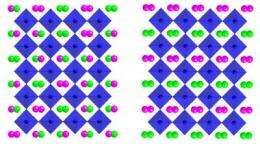Manganite oxide lattices (purple) doped with lanthanum (magenta) and strontium (green) have potential for use in spintronic memory devices, but their usual disorderly arrangement (left) makes it difficult to explore their properties. The ANL/NIST team's use of a novel orderly lattice (right) allowed them to measure some of the material's fundamental characteristics. Credit: Argonne National Laboratory
An advanced material that could help bring about next-generation "spintronic" computers has revealed one of its fundamental secrets to a team of scientists from Argonne National Laboratory (ANL) and the National Institute of Standards and Technology.
The material, constructed of two different compounds, might one day allow computers to use the magnetic spin of electrons, in addition to their charge, for computation. A host of innovations could result, including fast memory devices that use considerably less power than conventional systems and still retain data when the power is off. The team's effort not only demonstrates that the custom-made material's properties can be engineered precisely, but in creating a virtually perfect sample of the material, the team also has revealed a fundamental characteristic of devices that can be made from it.
Team members from ANL began by doing something that had never been done before-engineering a highly ordered version of a magnetic oxide compound that naturally has two randomly distributed elements: lanthanum and strontium. Stronger magnetic properties are found in those places in the lattice where extra lanthanum atoms are added. Precise placement of the strontium and lanthanum within the lattice can enable understanding of what is needed to harness the interaction of the magnetic forces among the layers for memory storage applications, but such control has been elusive up to this point.
"These oxides are physically messy to work with, and until very recently, it was not possible to control the local atomic structure so precisely," says Brian Kirby, a physicist at the NIST Center for Neutron Research (NCNR). "Doing so gives us access to important fundamental properties, which are critical to understand if you really want to make optimal use of a material."
The team members from ANL have mastered a technique for laying down the oxides one atomic layer at a time, allowing them to construct an exceptionally organized lattice in which each layer contains only strontium or lanthanum, so that the interface between the two components could be studied. The NIST team members then used the NCNR's polarized neutron reflectometer to analyze how the magnetic properties within this oxide lattice changed as a consequence of the near-perfect placement of atoms.
They found that the influence of electrons near the additional lanthanum layers was spread out across three magnetic layers in either direction, but fell off sharply further away than that. Tiffany Santos, lead scientist on the study from ANL, says that the measurement will be important for the emerging field of oxide spintronics, as it reveals a fundamental size unit for electronic and magnetic effects in memory devices made from the material.
"For electrons to share spin information-something required in a memory system-they will need to be physically close enough to influence each other," Kirby says. "By ordering this material in such a precise way, we were able to see just how big that range of influence is."
More information: T. S. Santos, B. J. Kirby, S. Kumar, S. J. May, J. A. Borchers, B. B. Maranville, J. Zarestky, S. G. E. te Velthuis, J. van den Brink and A. Bhattacharya. Delta doping of ferromagnetism in antiferromagnetic manganite superlattices. Physical Review Letters, Week ending Oct. 14, 2011, 107, 167202 (2011), DOI: 10.1103/PhysRevLett.107.167202
Provided by National Institute of Standards and Technology






















